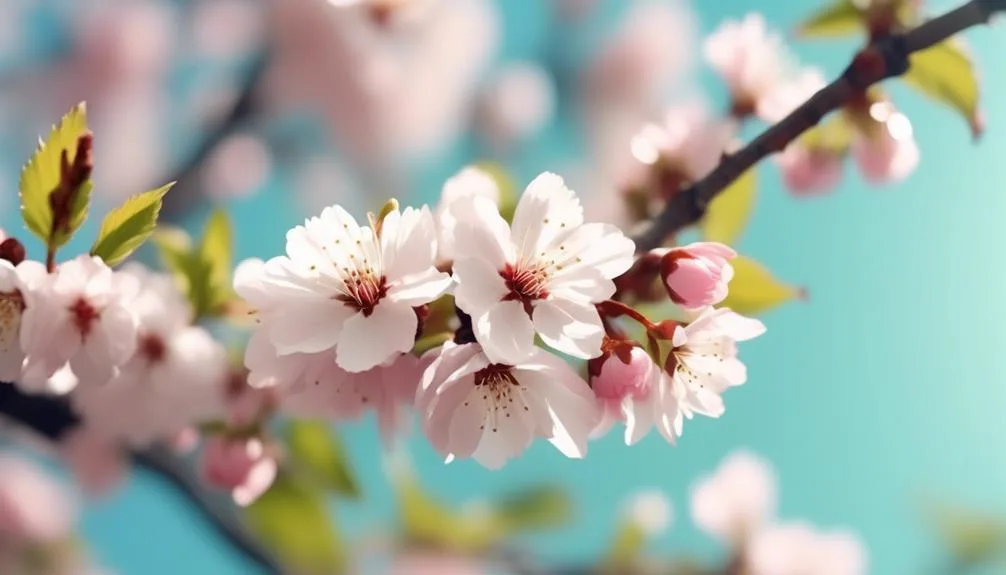You might have wondered if cherry blossoms are edible beyond just their beauty. Are these delicate flowers actually fit for consumption? Exploring their potential culinary uses may surprise you.
It's not as simple as it seems.
Edibility of Cherry Blossoms
You can eat cherry blossoms, but it's important to be aware of certain considerations regarding their edibility.
While cherry blossoms are often used for ornamental purposes, they also hold cultural significance in various parts of the world. In Japan, for example, the annual tradition of hanami, or flower viewing, celebrates the beauty of cherry blossoms and their fleeting nature.
These delicate flowers also carry health benefits, as they're rich in antioxidants and have been used in traditional medicine to alleviate inflammation and improve skin health.
However, it's crucial to ensure that the cherry blossoms you consume are free from pesticides or other contaminants.
With the right precautions, you can enjoy the cultural significance and potential health benefits of incorporating cherry blossoms into your diet.
Cherry Blossom Varieties
Various cherry blossom varieties bloom in different colors, shapes, and sizes, adding to the stunning beauty of these iconic flowers. Each variety holds its own unique charm, making cherry blossom viewing an enchanting experience.
Here are some popular cherry blossom varieties:
- Somei Yoshino: Known for its pale pink, almost white, flowers.
- Kanzan: Boasting magnificent double blossoms in vibrant pink hues.
- Shogetsu: Displaying elegant, semi-double white blooms with a hint of pink.
- Yaezakura: Featuring rich, deep pink petals in densely packed clusters.
- Shidare Zakura: Recognizable by its graceful weeping branches and delicate pink flowers.
These varieties play a significant role in cherry blossom symbolism and are celebrated in various cherry blossom festivals, where their diverse beauty is admired and cherished.
Culinary Uses of Cherry Blossoms
Cherry blossom varieties not only captivate with their diverse beauty, but they also offer intriguing culinary uses that have been cherished for centuries. When it comes to culinary uses, cherry blossoms are commonly used to make delicate and fragrant cherry blossom tea. The blossoms can also be used to infuse desserts such as cakes, cookies, and ice creams, adding a subtle floral flavor and a touch of elegance to the dishes. Below is a table summarizing the culinary uses of cherry blossoms:
| Culinary Use | Description |
|---|---|
| Cherry Blossom Tea | Delicate and fragrant tea made from cherry blossoms |
| Infused Desserts | Cakes, cookies, ice creams, and other desserts infused with cherry blossoms |
These culinary uses allow cherry blossoms to not only be visually captivating but also a delightful addition to various culinary creations.
Cherry Blossom Recipes
Discover delightful and inventive ways to incorporate cherry blossoms into your culinary creations with these inspiring cherry blossom recipes. Whether you're looking to infuse delicate floral notes into your tea or create a luscious dessert, cherry blossoms offer a unique and elegant touch to your dishes.
Here are some delightful cherry blossom recipes to elevate your culinary repertoire:
- Sakura Tea: Brew a soothing and aromatic tea by infusing cherry blossoms with hot water. The delicate flavor and beautiful pink hue make it a perfect choice for a relaxing afternoon.
- Cherry Blossom Ice Cream: Indulge in the creamy decadence of cherry blossom ice cream, where the subtle floral essence adds a sophisticated twist to a classic treat.
- Sakura Mochi: Delight in the traditional Japanese sweet treat, where soft rice cake filled with sweet red bean paste is wrapped in a pickled cherry blossom leaf.
- Cherry Blossom Syrup: Create a fragrant and floral syrup to drizzle over pancakes, waffles, or desserts for a burst of cherry blossom flavor.
- Cherry Blossom Scones: Infuse your scones with cherry blossoms for a delightful twist on a beloved baked good, adding a hint of floral elegance to your breakfast or afternoon tea.
Precautions When Consuming Cherry Blossoms
As you explore the culinary possibilities of cherry blossoms, it's important to be aware of precautions when consuming these delicate flowers.
Potential allergies are a significant consideration when incorporating cherry blossoms into your diet. Some individuals may have sensitivities to pollen or floral components, so it's essential to start with small amounts to gauge any adverse reactions.
When preparing cherry blossoms for consumption, ensure that they come from trees free of pesticides and other contaminants. Safe preparation techniques involve gently washing the blossoms in cold water to remove any debris and insects.
Additionally, it's crucial to source cherry blossoms from edible cherry tree varieties such as Prunus serrulata, specifically cultivated for culinary use, as other cherry tree species may not be safe for consumption.
Always prioritize caution and moderation when integrating cherry blossoms into your dishes.
Conclusion
Incorporate cherry blossoms into your culinary creations for a unique and delightful touch. Remember to source them from a safe and reputable source and enjoy experimenting with this wonderful seasonal ingredient.
Embrace the delicate and fragrant blossoms to elevate your dishes and savor the beauty of nature in every bite.

My interest in trees started when I first saw the giant sequoias in Yosemite.
I was a teenager then, and I remember thinking, “I need to learn more about this.”
That moment stuck with me.
A few years later, I went on to study forestry at Michigan Tech.
Since graduating, I’ve worked in a mix of hands-on tree care and community education.
I’ve spent over ten years helping people understand how to plant, maintain, and protect the trees in their neighborhoods.
I don’t see trees as just part of the landscape.
They are living things that make a real difference in our daily lives.
